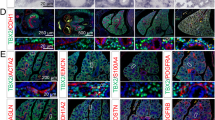Abstract
Cardiac morphogenesis involves substantial remodeling processes that include cell transdifferentiation and migration. The c-ets-1 protooncogene codes for a transcription factor that can transactivate a number of genes involved in developmental processes such as degradation of extracellular matrices and cell migration. We have immunolocated the ets-1 protein in the heart of quail and chick embryos between the Hamburger and Hamilton stages HH16 and HH37. In HH16–17 embryos, the ets-1 transcription factor was only detected in some endocardial cells and in most mesothelial and mesenchymal cells of the proepicardium. Ets-1 immunoreactivity increased markedly in the developing endocardial cushions, myocardium, epicardium and early subepicardial mesenchyme of HH18–19 embryos. By HH20–24 the immunoreactivity was found throughout the heart, with a stronger intensity in the areas of epithelial-mesenchymal transition of the endocardium and epicardium. In embryos between HH26 and HH33, ets-1 immunoreactivity increased in the cushion mesenchyme, atrioventricular endocardium, ventricular epicardium and subepicardial mesenchyme cells, but not in other areas of the heart. The immunoreactivity declined in the innermost part of the endocardial cushions. The subepicardial mesenchyme was particularly immunoreactive in these stages, coinciding with the development of the subepicardial vascular network. In fact, ets-1 colocalized with the quail vascular marker QH1 in the subepicardial mesenchymal cells. Ets-1-negative cells were abundant in the subepicardium and valvuloseptal tissue of the HH37 embryos. The results suggest that ets-1, probably through transactivation of genes such as urokinase-type plasminogen activator and matrix metalloproteinases, might play a crucial role in the differentiation of the cushion and subepicardial mesenchyme, the formation of the intratrabecular sinusoids and the early development of the cardiac vessels.
Similar content being viewed by others
Author information
Authors and Affiliations
Additional information
Accepted: 8 April 1998
Rights and permissions
About this article
Cite this article
Macías, D., Pérez-Pomares, J., García-Garrido, L. et al. Immunoreactivity of the ets-1 transcription factor correlates with areas of epithelial-mesenchymal transition in the developing avian heart. Anat Embryol 198, 307–315 (1998). https://doi.org/10.1007/s004290050186
Issue Date:
DOI: https://doi.org/10.1007/s004290050186




